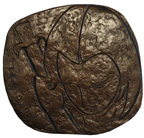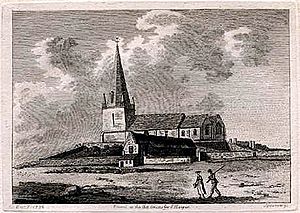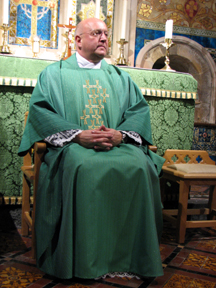The Vale Church, Guernsey facts for kids
St. Michel du Valle is a historic church located in Vale, Guernsey. It's a very old building with a rich past, serving the community for many centuries.
Contents
Early Christian Roots
In January 1949, a special stone was found outside the church's west door. This stone is very old, dating back to the 7th or 8th century. It suggests that Christians were worshipping here around the year 600 AD, or even earlier! There was also a chapel nearby, dedicated to a saint named Magloire, who was born around 535 AD. Even though the chapel is long gone, it shows that this area has been a place of Christian worship for a very long time.
The Priory and Monks
Around 968 AD, monks from a famous monastery called Mont Saint-Michel in Normandy, France, came to Guernsey. They wanted to start a religious community in the northern part of the island. It's thought that long ago, a land bridge might have connected the area near the Vale church to other parts of Guernsey before the sea broke through. This area, known as the Braye du Valle, used to become a separate island at high tide until 1806.
The monks' community, called the Priory of Mont Saint-Michel, was connected to the main Abbey in France. Today, only a small piece of a wall remains from the old Priory, located south of the church.
Gifts and Protection
According to old stories, Robert II, Duke of Normandy (who was the father of William the Conqueror) visited Guernsey in 1032. He gave land, now called the Clos du Valle, to the monks. Later, in 1061, pirates attacked the island. Duke William sent Sampson D'Anneville, who, with the help of the monks, drove the pirates away. As a reward, Sampson D'Anneville and the monks received half of the island between them. The monks' share was called Le Fief St Michel. This area included the parishes of St Saviour, St Pierre du Bois, Ste. Marie du Catel, and the Vale.
To protect people from pirates, a castle was built. It was called the Castle of Saint Michael, but today it's known as "Vale Castle." Major construction work on the castle was finished in 1117.
The Priory had an important court, second only to the Royal Court of Guernsey. Its official seal showed the Archangel Michael defeating Satan. This court continued to operate until 1862.
The Parish Church Building
The church's location makes it easy for sailors to spot from the sea. Before 1806, when the Braye du Valle was still open to the sea, you could even reach the church by boat at high tide!
The current church building was dedicated in 1117. It was built next to the Priory, which eventually stopped being used around 1414. Some of the Priory's wood was even used to repair Castle Cornet.
Unique Architecture
The church's design shows signs of the monks' influence. For example, its layout isn't perfectly straight. None of the angles are exactly square, and the walls aren't parallel. The main part of the church (the Chancel) is slightly out of line with the main seating area (the Nave). This unusual design is thought to represent the body of Jesus on the cross.
Inside the church, on the South wall near the Chancel, you can find a piscina. This is a special basin used for washing sacred vessels. There are four of these in the building. Look closely at the granite arch above the pulpit, and you'll see a carving of a spaniel's head. This was likely a special mark left by the stonemason, similar to one found at the Town Church.
Church Leadership Changes
In 1555, Thomas de Beaugy was the last Roman Catholic priest (Curé) of the Vale church. Later, in 1585, a Protestant minister from France took over. For a long time, the parishes of St. Sampson and the Vale were looked after by the same minister.
However, in 1859, the Crown decided that the two parishes should be separate again. The Rev. Thomas Bell became the Rector of the Vale church in 1859 and served until 1914. In 1904, the church added a beautiful mosaic behind the altar (called a reredos) to honor Thomas Bell's 50th year in the parish. Some church services were even held in French until the 1920s.
Guernsey's parishes were part of the Diocese of Coutances in Normandy until the late 1400s. They then moved to the Diocese of Salisbury and soon after to the Diocese of Winchester, where they remain today.
Recent Updates
A special stained glass window was placed over the Altar to remember Mr. J. H. Ingrouille, who passed away in 1945. During the German Occupation, he was imprisoned by the Nazis and died shortly after being freed. His body was brought back to Guernsey and buried at the Vale church.
Another stained glass window was added in 1963 to remember Mr. and Mrs. A. J. Robin. The Mothers' Union group also provided new blue carpets, curtains, and cushions for the church.
In 1966, the church's heating system was completely updated with a new gas boiler and radiators. The roof also got new slates and timbers in 1966 and 1967.
The Bells of the Church
The church's original bells were replaced in the 1500s with three new ones. These were hung in the base of the spire. In 1891, these old bells were melted down and, with added metal, six new bells were created. These new bells were a gift from the Rev. Thomas Bell and his wife, Blanche Henrietta Lihou, in memory of their son, Thomas Arthur Bell, who passed away in 1889.
The bells have a special inscription in French, explaining their history and dedication. The largest of the six new bells weighs about 63.4 hundredweight (a unit of weight). All six bells have the inscription "RECAST BY JOHN WARNER & SONS LONDON 1891".
In 1970, the bells were sent away to be retuned and rehung. In 2000, they were removed again for refurbishment. The bells are now rung from the ground floor, right where the congregation can see the bell ringers. Many special bell-ringing performances have taken place, including the first by a local group in 1980 to celebrate Queen Elizabeth the Queen Mother's 80th birthday.
The Church Clock
A clock with four faces was installed in the spire above the bells in 1898. This was to celebrate Queen Victoria's Diamond Jubilee, which happened the year before. The clock was originally powered by weights but was made electric in 1970. It plays Westminster chimes and strikes the hours.
Church Records
The church keeps records that go all the way back to 1580! The earliest ones are in poor condition, and entries were written in French until 1939. In 1970, all the registers needing repair were sent to an expert in England to be carefully preserved.
Miscellaneous Features
In 1967, a complete set of special robes (Vestments) was given to the church. Another beautiful robe, called 'the Agnus Dei' Cope, was presented in 1970.
The church also has several important silver items used during services:
- Two chalices (cups), dated 1794.
- One chalice from the late 1800s.
- Two patens and two salvers (plates), from 1794.
- Two flagons (pitchers), from 1860 and 1936.
- One ciborium (container for wafers), from 1966.
More recently, since 1967, a silver Chalice, a Ciborium, and a Wafer Box have also been given to the church.
The lectern, where readings are given, was a gift from Dean Thomas Bell on his golden wedding anniversary.
In 2007, the church hosted its first-ever art exhibition, featuring paintings and sculptures by Canadian artist Christian Corbet, who has family ties to the Vale. Mr. Corbet donated all the money from sales, raising over £5,000 for the church. In 2007, Christian Corbet also donated a bronze art medallion called "St. Michael and His Sword" to the church's collection. 
The German Occupation
During the German Occupation of the Channel Islands in World War II, many people were evacuated or deported. This meant there were fewer Anglican clergy (church leaders) on the island. The Rector of St. Michel du Valle was deported in 1942. His duties were taken over by the Rector of St. Sampson's, who then had four churches to look after!
To help out, regular church members (the laity) led services across the island. One of these was Mr. Harold Brache, a Licensed Reader. Because of shortages of fuel for light and heat, and due to curfews, evening services (Evensong) had to be held earlier, between 2:30 PM and 4:00 PM. No Confirmations could take place between 1941 and 1944.
Church Leaders Through History
Here are some of the people who have led the church over the centuries:
Priors of the Vale, Vicars of the Vale and Rectors of St Sampson
- 1156 Robert, priest and Dean of Valle
- 1179 Richard, de Vyville (Huivilla), Prior
- 1249 Henry, Canon of Blanchelande
- 1306 Jean de la Port (Duport), later Abbot of Mont Saint-Michel
- 1323 Jean Le Caretier
- 1324 Renant Pastey
- 1325 William Fabri (Guillaume Le Febre)
- 1327 Jourdain Poingdestre
- 1335 Andre de la Porte (Duport)
- 1352 Richard Tyffanye
- 1364 Geoffrey de Carteret
- 1368 Jean de Guerin
- 1372 Brefard
- 1479 Guillaume Paul
Rectors of the Vale
- 1473 Jean Le Carpentier
- 1480 Jean Bequerel
- 1490 Jean Corneille
- 1497 Pierre Houssaye, died 1503
- 1503 George Elys, Dean 1509, Resigned 1513
- 1513 Jean de Quetteville
- 1550 Jean Hurt
- 1555 Thomas de Beaugy
- 1585 Jean de Cherpont, died 1587
- 1587 Noel Perruquet
- 1590 Jacques Guyneau, died 1592
- 1592 Jean Marchand
- 1598 Jeremy Valpy, died 1606
- 1606 Pierre Painsec
- 1607 Nicholas Efart
- 1607 Thomas Miletjun
- 16- Jean Boulon
- 1652 Thomas Piquot, died 1604
- 1655 Thomas Le Marchant, resigned 1662
- 1662 Philip Brashmart, died 1663
Vicars of the Vale and Rectors of St Sampson (United Parishes)
|
Rectors of the Vale (Separate Parish)
|



